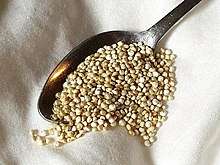Pseudocereal
A pseudocereal is one of any non-grasses that are used in much the same way as cereals (true cereals are grasses). Their seed can be ground into flour and otherwise used as cereals. Examples of pseudocereals are amaranth (Love-lies-bleeding, red amaranth, Prince-of-Wales-feather), quinoa, and buckwheat.[1]

Quinoa is not a grass. Its seeds have been eaten for 6,000 years.
Common pseudocereals
- Amaranth (Love-lies-bleeding, Red amaranth, Prince-of-Wales-feather)
- Breadnut
- Buckwheat
- Chia
- Cockscomb (also called quail grass or soko)
- Pitseed Goosefoot
- Cañahua
- Quinoa
- Wattleseed (also called acacia seed)
Production
The following table shows the annual production of some pseudocereals in 1961,[2] 2010, 2011, 2012, and 2013 ranked by 2013 production.[3]
| Grain | Worldwide production (millions of metric tons) |
Notes | ||||
|---|---|---|---|---|---|---|
| 1961 | 2010 | 2011 | 2012 | 2013 | ||
| Buckwheat | 2.5 | 1.4 | 2.3 | 2.3 | 2.5 | A pseudocereal in the family Polygonaceae that is used in Eurasia and to a minor degree the United States and Brazil. Major uses include various pancakes, groats and noodle production. |
| Quinoa | 0.03 | 0.08 | 0.08 | 0.08 | 0.10 | A pseudocereal in the family Amaranthaceae, traditional to the Andes, but increasingly popular elsewhere. |
Other grains that are locally important, but are not included in FAO statistics, include:
- Amaranth, an ancient pseudocereal, formerly a staple crop of the Aztec Empire and now widely grown in Africa.
- Kañiwa, close relative of quinoa.
gollark: Yes it is.
gollark: Neat.
gollark: You know what's MORE based? Multi-gigabyte-per-second (de)compression.
gollark: But zstandard is good regardless of Facebookness?
gollark: It isn't HelloBoi, as they didn't submit an entry. Keep up.
References
- "Glossary of Agricultural Production, Programs and Policy". University of Arkansas Division of Agriculture. Archived from the original on 2007-02-14. Retrieved 2006-12-31.
- 1961 is the earliest year for which FAO statistics are available.
- "ProdSTAT". FAOSTAT. Retrieved 26 December 2006.
This article is issued from Wikipedia. The text is licensed under Creative Commons - Attribution - Sharealike. Additional terms may apply for the media files.